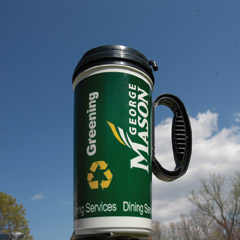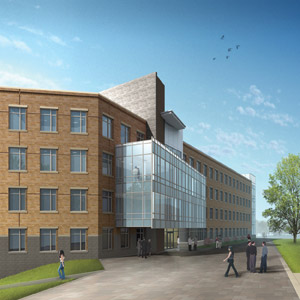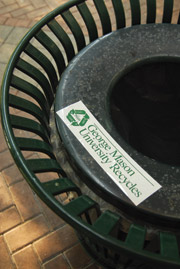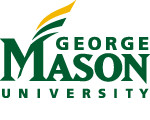Mason Strikes Gold with Greening Efforts
At Mason, green has always been a popular color, but in recent years, it has come to indicate more than just school spirit
By Tara Laskowski, MFA ’06, and Colleen Kearney Rich, MFA ‘95

Susan Corry, Mason’s energy and sustainability manager
It seems that just about every week a new report details the damage being wrought upon the Earth as a result of profligate energy consumption. There is also strong evidence that across the country, people are taking notice—and action. Environment-friendly buildings, hybrid cars, and energy-efficient commuting are becoming more the norm rather than the exception.
At Mason, where green is already a popular color, several initiatives are under way on different fronts. Perhaps the biggest step the university has taken to date was to sign an energy-saving performance contract with Siemens Building Technologies Inc. in 2005. The contract allowed the university to upgrade or replace outdated, inefficient mechanical equipment and systems with no upfront costs. Mason has reduced its carbon dioxide emissions by more than 32 million pounds this year and will do so annually for the next 15 years, the equivalent of taking 2,800 cars off the road. The university also continues to save a guaranteed minimum of more than $1 million per year in avoided energy costs.

Last year, the university retrofitted or replaced all the lighting fixtures—approximately 19,000—on the Fairfax Campus in an effort to reduce energy consumption by as much as 75 percent. It also replaced incandescent lighting with compact fluorescent lamps and is gradually installing occupancy sensors that automatically turn on lights when a person enters a room and turn them off during periods of inactivity.
“Not only does this project save money for the taxpayers of Virginia, it also is beneficial to the environment. By saving energy, we are also reducing our carbon emissions,” says Susan Corry, energy and sustainability planning manager at Mason.
Also in the plans are “green” buildings for Mason’s continuously growing campus. According to Corry, all new university buildings will be designed to meet the Leadership in Energy and Environmental Design (LEED) silver standard. The LEED Green Building Rating system is a nationally accepted benchmark for the design, construction, and operation of buildings and promotes sustainability by focusing on five key areas of human and environmental health: sustainable site development, water savings, energy efficiency, materials selection, and indoor environmental quality. The university has already registered a number of projects with the U.S. Green Building Council, which maintains the certification system.

The new building for the Volgenau School of Information Technology and Engineering is one of the first on campus to seek a LEEDS silver standard.
Other efforts include the following:
- A university-wide environmental task force has been formed to look at making the campus more energy efficient and environmentally friendly. The first sustainability assessment of the Green Campus Task Force is available online at green.gmu.edu.
- Faculty members are attempting to put more community service and conservation skills into their curriculum.
- The university’s Facilities Management Office has hired an energy management specialist and a sustainability coordinator to help manage the green aspect of buildings and maintenance.
- Mason’s Dining Services began selling reusable Greening Mason travel mugs for $2.99 last September. The mugs can be refilled with premium coffee at a lower cost—saving customers cash and preventing disposable cups from hitting the trash. Michael Galvin, marketing and community affairs manager for Dining Services, says approximately 1,100 mugs are already in circulation.
- Transportation Services has teamed up with Zipcar to provide students and employees a more convenient and environmentally sound way to get around. The program involves online or telephone reservations of communal vehicles parked around the Washington, D.C., area, including Mason’s Arlington Campus, as well as the Vienna Metro station.Vehicles included in the program include Mini Coopers and hybrids such as the Toyota Prius.
- As a participant in the Commonwealth Commuter Choice program, Mason covers the costs of employees who travel to work by public transportation or vanpool, up to $110 a month. Not only does this tax-free benefit help employees’ budgets, it also reduces the number of vehicles on the roads.
 Recycling Figures for 2006
Recycling Figures for 2006
- 4,390 lbs. of aluminum generated $2,555.00
- 144,500 lbs. of white and office paper generated $11,773.90
- 171,820 lbs. of mixed paper generated $1,463.94
- 319,230 lbs. of cardboard generated $5,080.47
- 35,380 lbs. of newspaper generated $779.80

